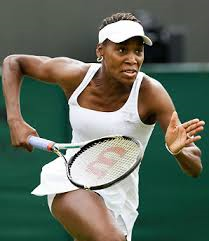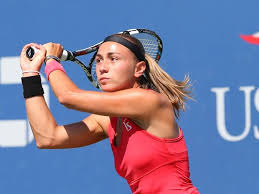Whether measured by participation numbers, by prize money, or by global reach, tennis is the world’s largest professional sport for women. Most of the world’s best known (and wealthiest) female athletes are tennis players.
Beginning tomorrow, 128 players representing 33 countries will gather in Flushing Meadows, New York, to contest the women’s singles competition at the final Grand Slam of 2015, the U.S. Open. This year’s tournament promises to showcase great athleticism, fierce competition, and quite possibly some history-making.
Here are nine reasons to watch:
1. Serena Williams
No player has more impressively dominated women’s tennis over the past 15 years than 34-year-old American Serena Williams. With her powerful and unreadable serve, aggressive groundstrokes, great court coverage, and reliable shot selection, Serena has won 21 Grand Slams and has notched up 255 weeks as world #1. She owns more titles, counting singles, doubles, and mixed doubles, than any other active player, male or female. She has twice completed a “surface slam” – Grand Slam titles on three different surfaces (clay, grass, and hard court) within the same calendar year. She is the only player of either gender to have won singles titles at three different Grand Slams at least six times each.
Serena comes into this year’s U.S. Open with a chance to make history. At Wimbledon in early July of this year, she completed her second “Serena Slam,” amassing four straight Grand Slam titles over a twelve month period. At the 2015 U.S. Open, Serena has a chance to become only the second woman in tennis’ modern era, and only the fifth woman of all time, complete the rare Calendar-Year Grand Slam.
Serena’s draw in New York looks brutal. To win, she might have to beat three former Slam champions (including her sister Venus) and a former Slam finalist who has beaten her before. Especially in light of the stress she clearly experienced at the summer warm-up events in Toronto and Cincinnati, no one can take Serena’s success in New York this year for granted.
That said, in 2015 more than in any other year, Serena has demonstrated tenacity and determination. Quite often, she has gotten into trouble by losing a first set, and every time save one that she has put herself in that predicament she has found a way to claw back and win.
Tips
Serena’s early matches might be relatively straightforward, but she will face tough fights every beginning in the third round. Every match thereafter promises athleticism, virtuosity, and drama.
2. Grand Slam Winners Lurking in the Draw
The U.S. Open women’s draw features eight players in addition to Serena Williams who have won Grand Slam titles. Any of them could contend for the title if the draw were to break her way.
Victoria Azarenka (Belarus) Australian Open 2012, Australian Open 2013.
Ana Ivanovic (Serbia) French Open 2008.
Svetlana Kuznetsova (Russia) U.S. Open 2004, French Open 2009.
Petra Kvitova (Czech Republic) Wimbledon 2011, Wimbledon 2014.
Francesca Schiavone (Italy) French Open 2010.
Maria Sharapova (Russia) Wimbledon 2004, U.S. Open 2006, Australian Open 2008, French Open 2012, French Open 2014.
Sam Stosur (Australia) U.S. Open 2011.
Venus Williams (United States) Wimbledon 2000, U.S. Open 2000, Wimbledon 2001, U.S. Open 2001, Wimbledon 2005, Wimbledon 2007, Wimbledon 2008.
Tips
Try to see Schiavone or Kuznetsova in the first couple of rounds. Among the eight players listed here, Schiavone and Kuznetsova face a relatively high risk of early elimination. Matches featuring any of these players in the second week should be corkers!
3. Power Hitters
A tall tennis player is usually a powerful player who can rely upon blazing serves and sharply hit, deep shots to move her opponents around and control the progression of a point. Height and wingspan certainly helped propel Azarenka (6’0″), Sharpova (6’2″), Kvitova (6’0″), Ivanovic (6’0″), and Venus Williams (6’1″) to their Grand Slam titles.
Among the younger players rising in the rankings are several who can be classified as power players. Two who have had the greatest impact at the Grand Slams are:
Garbiñe Muguruza of Spain (6’0″), who chalked up a big win over Serena Williams at the 2014 French Open.
Jelena Jankovic of Serbia (5’10”), who reached the U.S. Open final in 2008.
Eugenie Bouchard of Canada (5’10”), who reached the Wimbledon final in 2014.
Tips
Choose a power player’s match to enjoy a display of strength and harnessed aggression. (To see Bouchard, you may want to find her first- or second-round match. Her 2015 season has been a series of disastrous early losses.)
4. Defenders
Tennis’ smaller players, who usually cannot call upon the strength and leverage required to compete with their taller opponents in the arena of power, often become expert in defense – getting every ball back into play until an opponent either sends a shot out or leaves a ball short and vulnerable to attack.
Excellent defense requires speed, fitness, patience, anticipation, adaptability, and good decision-making. Among the sport’s best defenders are:
Caroline Wozniacki of Denmark (5’10”), a former world #1 who competed in the U.S. Open finals in 2009 and 2014.
Sara Errani of Italy (5’5″), who has reached a Grand Slam singles final (at the 2012 French Open) and won five Grand Slam titles in doubles.
Dominika Cibulková of Slovakia (5’3″), finalist in the 2014 Australian Open.
Tips
Defenders’ matches tend to be longer than the power players’ matches, because they almost inevitably involve longer rallies. Stylistically, a defender’s matches can be gripping and engaging due to a higher concentration of relatively complex points.
5. Shot-makers
Some of most entertaining matches at every Slam are produced by the special breed of player who are shot-makers – those who compensate for a lack of power with creativity, guile, unpredictability, and pinpoint accuracy.
Among the most accomplished of these racquet virtuosi are:
Simona Halep of Romania (5’6″), who reached the French Open final in 2014.
Agnieszka “Aga” Radwańska of Poland (5’8″), nicknamed “Ninja” for her craftiness, who competed in the 2012 Wimbledon final.
Tips
Both Halep and Radwanska have wins over Serena Williams. They are highly accomplished players who can be great fun to watch.
6. Meltdowns and Outbursts
As is the case on the men’s side of the sport, women’s tennis matches can at times be seasoned with outbursts, arguments, and/or loss of emotional control. On both the men’s side and the women’s, there are a few players who are more likely than others to inject drama into their matches.
Jankovic has been known to scream at her coach on court and argue with the umpire or with her opponent.
Alize Cornet of France is renowned for showing her feelings on the court.
Camille Giorgi of Italy brings to every match sharp hitting and a matching emotional intensity, which occasionally boils over into histrionics.
Tips
Cornet, Giorgi, and Jankovic are all top-flight players who should win at least their first few rounds in New York. It’s not impossible that you will witness some heavy drama if you watch one of their matches.
7. Yells and Shrieks
A discussion of the U.S. Open women’s draw would be incomplete without a few words about the politically touchy subject of grunts and screaming on the court. Female players draw frequent criticism for their high-pitched grunts, shrieks, and screams that grate on the ears of many fans. The scolded players respond, at times indignantly, by pointing that that the tennis men grunt too.
It is true that many male players grunt. Two in particular, Argentina’s Carlos Berlocq and Spain’s Marcel Granollers, are often cited by fans as especially hard on the ears, at times drawing comparisons to wounded ruminant mammals.
Nadal produces a nasal grunt that is at times more of a moan. David Ferrer emits a guttural growl after every shot which is as regular as clockwork. Andy Murray does much the same. Novak Djokovic produces a distinctive heh-ENHHH, especially when he is tired. Even Roger Federer grunts occasionally on second serves and defensive backhands.
Murray, Ferrer, and Spain’s Fernando Verdasco each produce at certain moments an “Argh!” sound that roughly translates to, “Damn! I don’t want to have run for that drop shot.”
The female players are correct when they point out that the men also make noise on the court, but, for better or for worse, the higher-pitched sounds produced by the women are more offensive to many fans.
With every shot, Sharapova produces a shriek that is loud at the beginning of a match and deafening if she reaches a tight third set. Azarenka emits a descending operatic glissando that has been aptly called “a ghost going down a waterslide.” Kuznetsova generates a deafening nasal whine that makes it sound as though she is in terrible pain.
Serena Williams’ screams vary throughout a match and seem to correlate with emotional ups and downs. Errani and Muguruza produce predictable “AHH!” sounds, while Schiavone specializes in, “Ah-HEE!”
Tip
The MUTE button can be your friend.
8. Youngsters
Nearly every Slam delivers the excitement of a break-out performance by a rising star. In 2013, American 17-year-old Victoria Duval electrified a night crowd by upsetting defending champion Stosur. In 2014, it was 15-year-old Cici Bellis who brought down the house by upsetting Cibulkova.
Three young players who have a chance to make headlines at the 2015 U.S. Open:
Aleksandra Krunić, 22, of Serbia, who thrilled a night crowd in 2014 with a near-upset of Azarenka.
Elina Svitolina, 20, of Ukraine, who has risen steadily up the rankings and currently sits at 15.
Belinda Bencic, 18, of Switzerland, who scored an impressive win over Serena Williams in Toronto in early August of this year.
Tip
A match featuring any of these three players, and especially a Bencic match, is worth going out of one’s way to see.
9. Americans
There are 22 American players in the women’s draw. Four are seeded in the top 32. Three are qualifiers. Seven are wildcards.
Two Americans play each other in the first round.
The U.S. Roster
- Madison Brengle
- Louise Chirico
- Samantha Crawford
- Lauren Davis
- Irina Falconi
- Nicole Gibbs
- Sofia Kenin
- Madison Keys (seeded 19)
- Vania King
- Varvara Lepchenko
- Jamie Loeb
- Bethanie Mattek-Sands
- Christina McHale
- Jessica Pegula
- Alison Riske
- Shelby Rogers
- Sloane Stephens (seeded 29)
- Anna Tatishvili
- Coco Vandeweghe
- Sachia Vickery
- Serena Williams (seeded 1)
- Venus Williams (seeded 23)
Predictions
Without reference to probable winners and losers, here are few prognostications:
- Serena Williams will drop the first set of at least one of her matches in New York.
- Serena Williams will win her first match that requires a third set.
- Eugenie Bouchard will be thrilled if she reaches the third round.
- Madison Keys will play her first night match at the U.S. Open when she faces Aga Radwanska in the third round.
- The women’s quarterfinals, semifinals, and final will all be excellent matches.




















